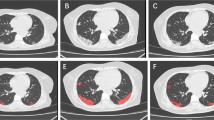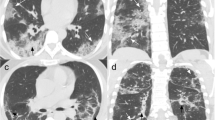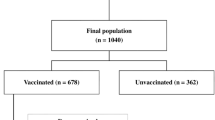Abstract
Background
The Delta variant of COVID-19 has emerged and spread globally since May 2021 and has been reported in more than 70 countries. The status of the vaccination, symptom onset time, and CT imaging signatures in the infected population have not been fully investigated and clarified.
Methods
This study included 131 patients who were infected with the Delta variant of COVID-19. After screening, 106 patients with 458 follow-up CT scans were retrospectively selected and divided into complete and incomplete vaccination groups (66 and 40 patients, respectively). Imaging features were automatically extracted, and infection distribution in lung fields and progression pattern tendency were investigated. Furthermore, we extracted the most related clinical and imaging features to establish a vaccination status classification model. An independent testing dataset with 55 patients from another inpatient ward was enrolled to evaluate the generalizability of the model.
Results
The severity of infection in the lung and lung fields of the complete vaccination group was overall lower than those of the incomplete vaccination group. A relatively earlier peak CT abnormality was found on days 8–11 in the complete vaccination group than in the incomplete vaccination group on days 12–15 after the first positive PCR time. The vaccination status classification model achieved the highest performance with an AUC of 0.929 and accuracy of 0.864 in the testing set and an AUC of 0.858 and accuracy of 0.727 in the independent testing set.
Conclusion
In summary, compared to the incomplete vaccination group, the fully vaccinated patients had milder CT abnormalities and earlier peak time for chest impairment. Therefore, the vaccination status is determinable through dynamic imaging and clinical features.






Similar content being viewed by others
Availability of data and materials
All data generated or analyzed during this study are included in this published paper.
References
Lopez Bernal J, Andrews N, Gower C, et al. Effectiveness of Covid-19 vaccines against the B.1.617.2 (Delta) variant. N Engl J Med. 2021;385(7):585–94.
Chen Y, Shen H, Huang R, Tong X, Wu C. Serum neutralising activity against SARS-CoV-2 variants elicited by CoronaVac. Lancet Infect Dis. 2021;21(8):1071–2.
Chen W, Zhang J, Qin X, et al. SARS-CoV-2 neutralizing antibody levels are correlated with severity of COVID-19 pneumonia. Biomed Pharmacother. 2020;130: 110629.
Han X, Fan Y, Alwalid O, et al. Six-month follow-up chest CT findings after severe COVID-19 pneumonia. Radiology. 2021;299(1):E177–86.
Pan F, Ye T, Sun P, et al. Time course of lung changes at chest CT during recovery from Coronavirus disease 2019 (COVID-19). Radiology. 2020;295(3):715–21.
Schalekamp S, Bleeker-Rovers CP, Beenen LFM, et al. Chest CT in the Emergency Department for diagnosis of COVID-19 pneumonia: Dutch experience. Radiology. 2021;298(2):E98–106.
Zhou Y, Ren H, Wang S, et al. The evolution of chest CT findings from admission to follow-up in 30 moderate to severe adult patients with COVID-19 pneumonia. Chin J Acad Radiol. 2021;4(1):71–7.
Komolafe TE, Cao Y, Nguchu BA, et al. Diagnostic test accuracy of deep learning detection of COVID-19: a systematic review and meta-analysis. Acad Radiol. 2021;28(11):1507–23.
Li L, Qin L, Xu Z, et al. Using artificial intelligence to detect COVID-19 and community-acquired pneumonia based on pulmonary CT: evaluation of the diagnostic accuracy. Radiology. 2020;296(2):E65–71.
Shan F, Gao Y, Wang J, et al. Abnormal lung quantification in chest CT images of COVID-19 patients with deep learning and its application to severity prediction. Med Phys. 2021;48(4):1633–45.
Shi F, Wang J, Shi J, et al. Review of artificial intelligence techniques in imaging data acquisition, segmentation, and diagnosis for COVID-19. IEEE Rev Biomed Eng. 2021;14:4–15.
Ouyang X, Huo J, Xia L, et al. Dual-sampling attention network for diagnosis of COVID-19 from community acquired pneumonia. IEEE Trans Med Imaging. 2020;39(8):2595–605.
Wu J, Xia Y, Wang X, et al. uRP: an integrated research platform for one-stop analysis of medical images. Front Radiol. 2023;3:1153784.
Han M, Zhang Y, Zhou Q, et al. Large-scale evaluation of V-Net for organ segmentation in image guided radiation therapy. In: Medical imaging 2019: image-guided procedures, robotic interventions, and modeling, vol 10951, pp 167–173
Shi F, Wei Y, Xia L, et al. Lung volume reduction and infection localization revealed in Big data CT imaging of COVID-19. Int J Infect Dis. 2021;102:316–8.
Shi F, Xia L, Shan F, et al. Large-scale screening to distinguish between COVID-19 and community-acquired pneumonia using infection size-aware classification. Phys Med Biol. 2021;66(6): 065031.
Sun X, Xu W. Fast implementation of DeLong’s algorithm for comparing the areas under correlated receiver operating characteristic curves. IEEE Signal Process Lett. 2014;21(11):1389–93.
Wang Y, Dong C, Hu Y, et al. Temporal changes of CT findings in 90 patients with COVID-19 pneumonia: a longitudinal study. Radiology. 2020;296(2):E55–64.
Hagan LM, McCormick DW, Lee C, et al. Outbreak of SARS-CoV-2 B.1.617.2 (Delta) variant infections among incarcerated persons in a federal prison—Texas, July–August 2021. MMWR Morb Mortal Wkly Rep. 2021;70(38):1349–54.
Hu Z, Tao B, Li Z, et al. Effectiveness of inactive COVID-19 vaccines against severe illness in B.1.617.2 (Delta) variant-infected patients in Jiangsu, China. Int J Infect Dis. 2022;116:204–9.
Vatti A, Monsalve DM, Pacheco Y, Chang C, Anaya JM, Gershwin ME. Original antigenic sin: a comprehensive review. J Autoimmun. 2017;83:12–21.
Acknowledgements
We would like to thank all of the team members in this study.
Funding
This study was supported in part by the 66th Batch of China Postdoctoral Science Foundation Projects (2019M661805) and a Research Grant of Key Project supported by Medical Science and Technology Development Foundation, Nanjing Department of Health (YKK18062), Jiangsu Province, China, and the Fundamental Research Funds for the Central Universities (021414380462, 021414380484). This work was funded in part by the National Science and Technology Innovation 2030-Major Project (2021ZD0111103).
Author information
Authors and Affiliations
Contributions
Conceptualization, BZ. Data curation, JD and YS. Formal analysis, XH and CL. Investigation, PL and ZW. Methodology, XX and JL. Project administration, YG. Resources, XZ. Software, JH. Supervision, CY, YY and BZ. Validation, XX. Writing—original draft, XX, JH, and YW. Writing—review and editing, XX, JH, YW, JD, JL, CY, XP, YS, XZ, PL, ZW, XH, CL, YY, YG, FS, and CD.
Corresponding authors
Ethics declarations
Conflict of interest
The authors declare that they have no competing interests.
Ethical approval and consent to participate
All methods were carried out in accordance with relevant guidelines and regulations. This study was approved by the ethics committees of the Second Affiliated Hospital of Nanjing University of Chinese Medicine, Nanjing, China. Informed consent was obtained from each participant before enrollment.
Additional information
Publisher’s Note
Springer Nature remains neutral with regard to jurisdictional claims in published maps and institutional affiliations.
Supplementary Information
Below is the link to the electronic supplementary material.
Rights and permissions
Springer Nature or its licensor (e.g. a society or other partner) holds exclusive rights to this article under a publishing agreement with the author(s) or other rightsholder(s); author self-archiving of the accepted manuscript version of this article is solely governed by the terms of such publishing agreement and applicable law.
About this article
Cite this article
Xin, X., Hu, J., Wei, Y. et al. Vaccination effect on patients with Delta variant of COVID-19 pneumonia: a study of longitudinal dynamic chest CTs using artificial intelligence model. Chin J Acad Radiol 7, 92–101 (2024). https://doi.org/10.1007/s42058-024-00143-2
Received:
Revised:
Accepted:
Published:
Issue Date:
DOI: https://doi.org/10.1007/s42058-024-00143-2




